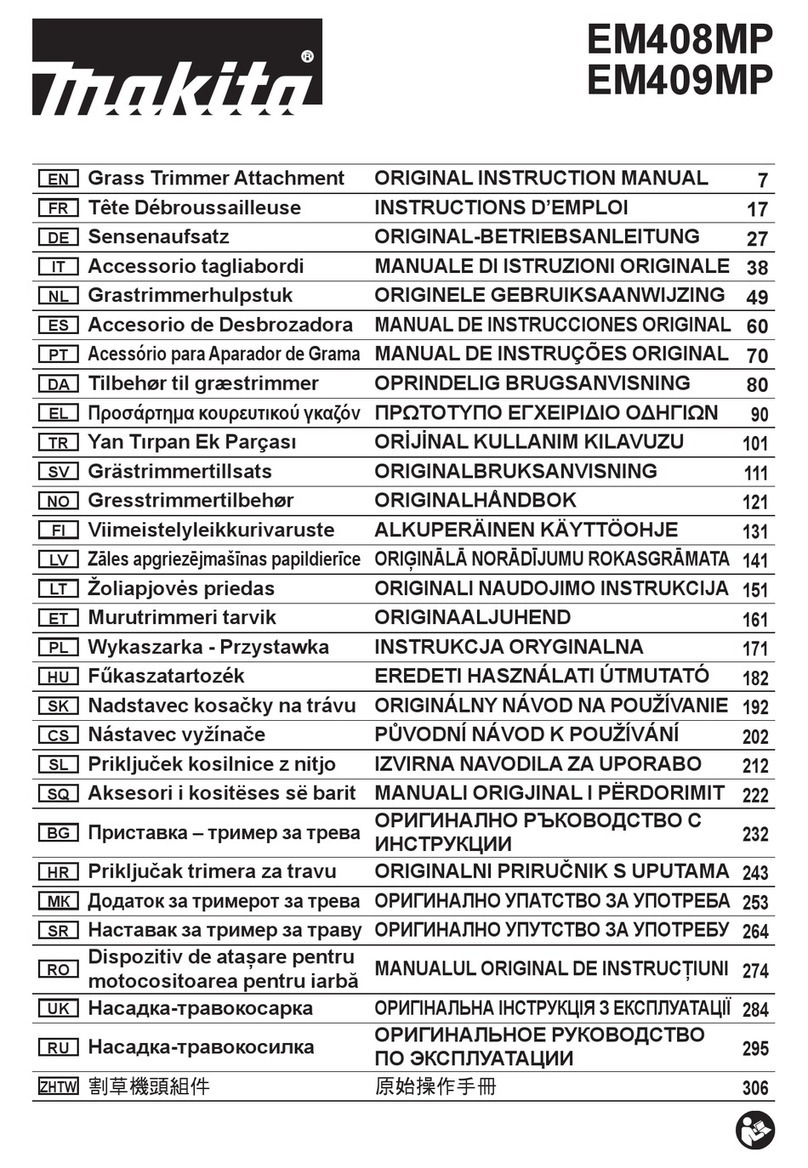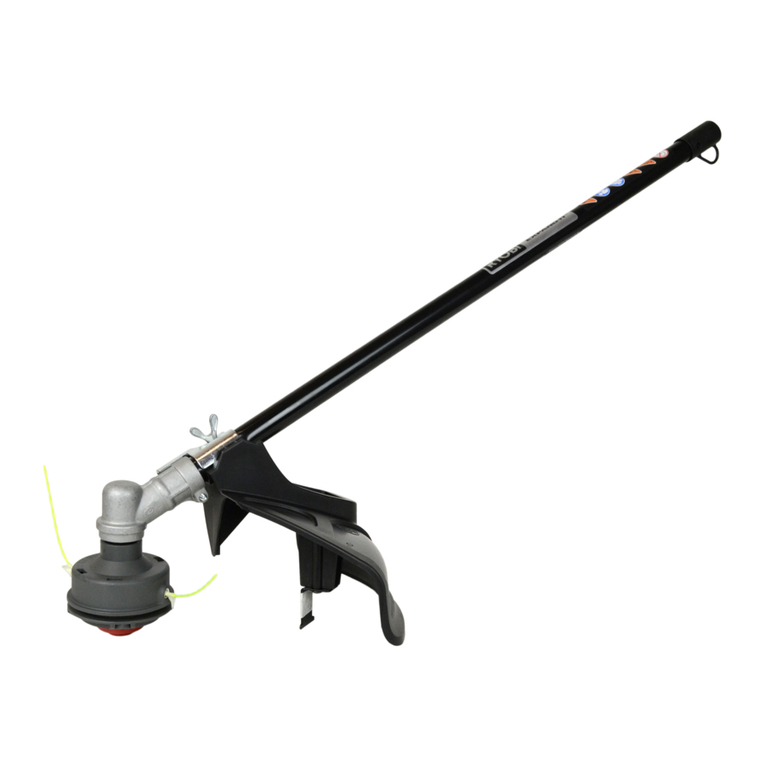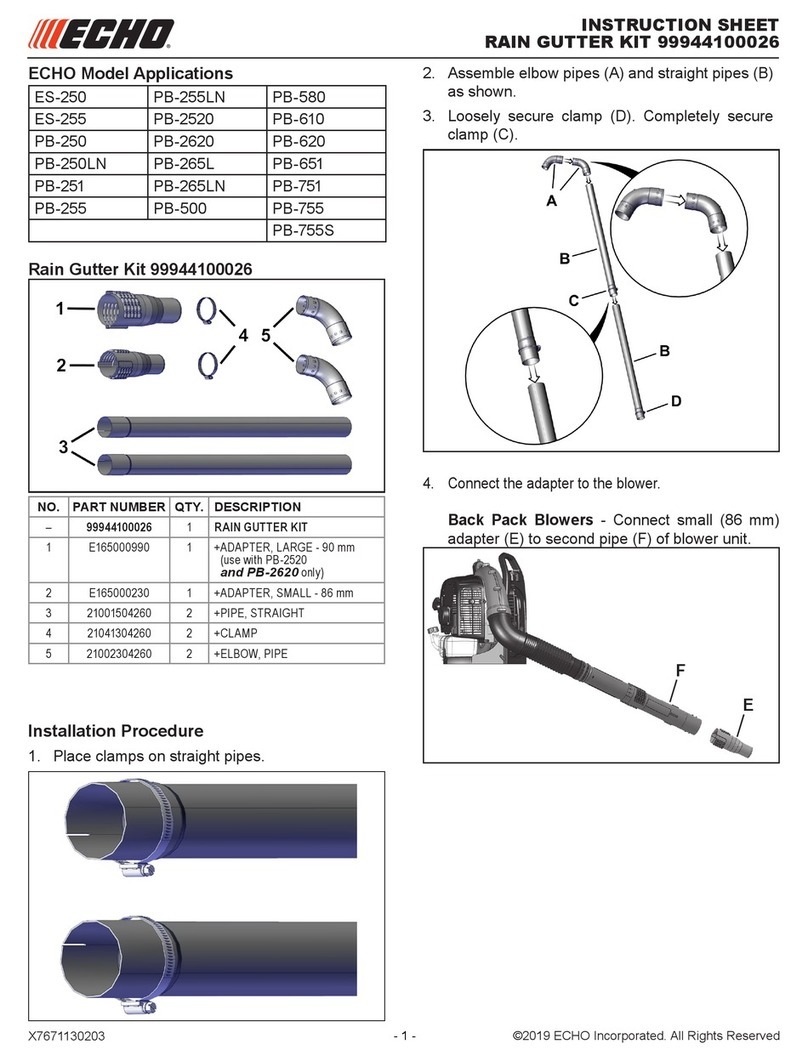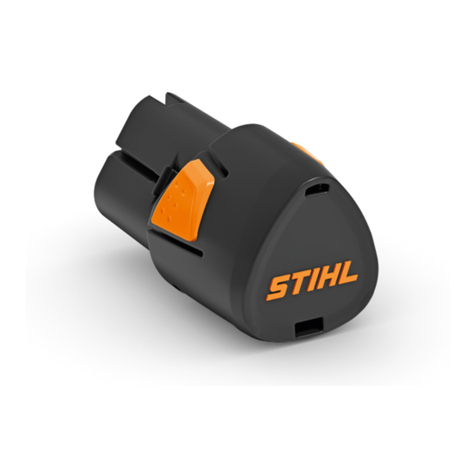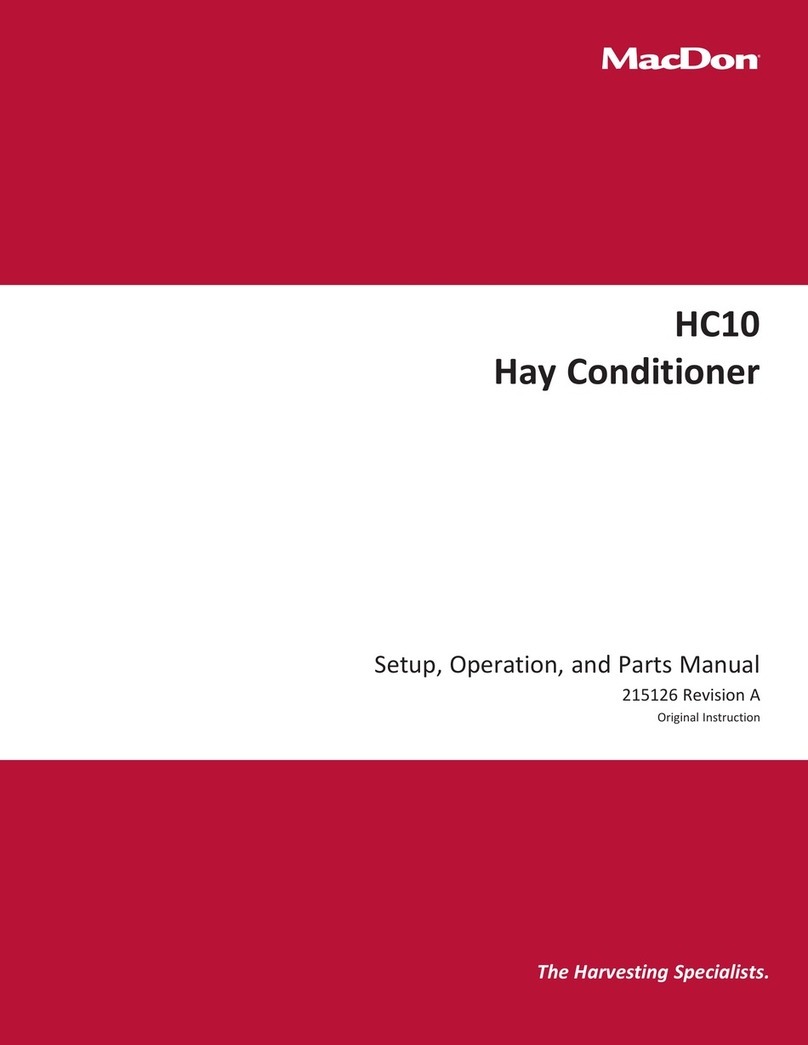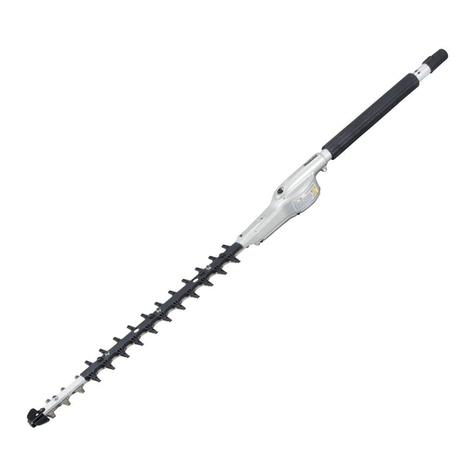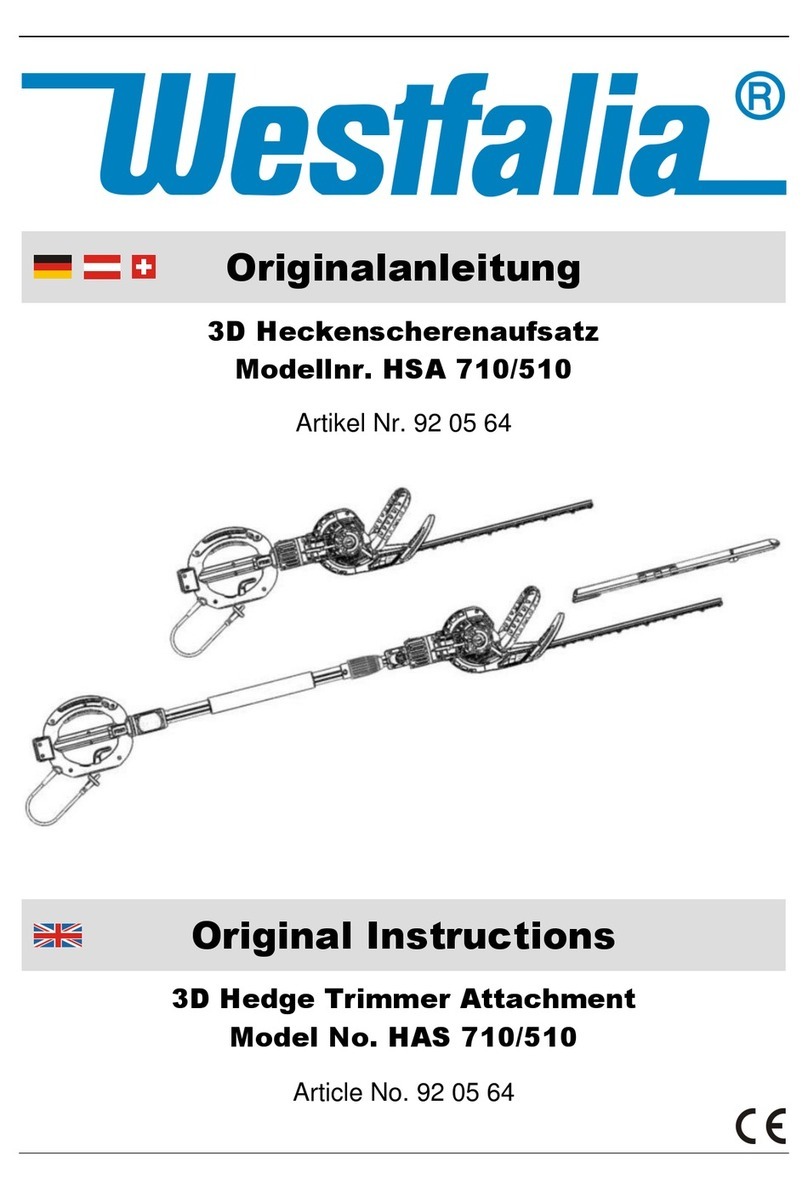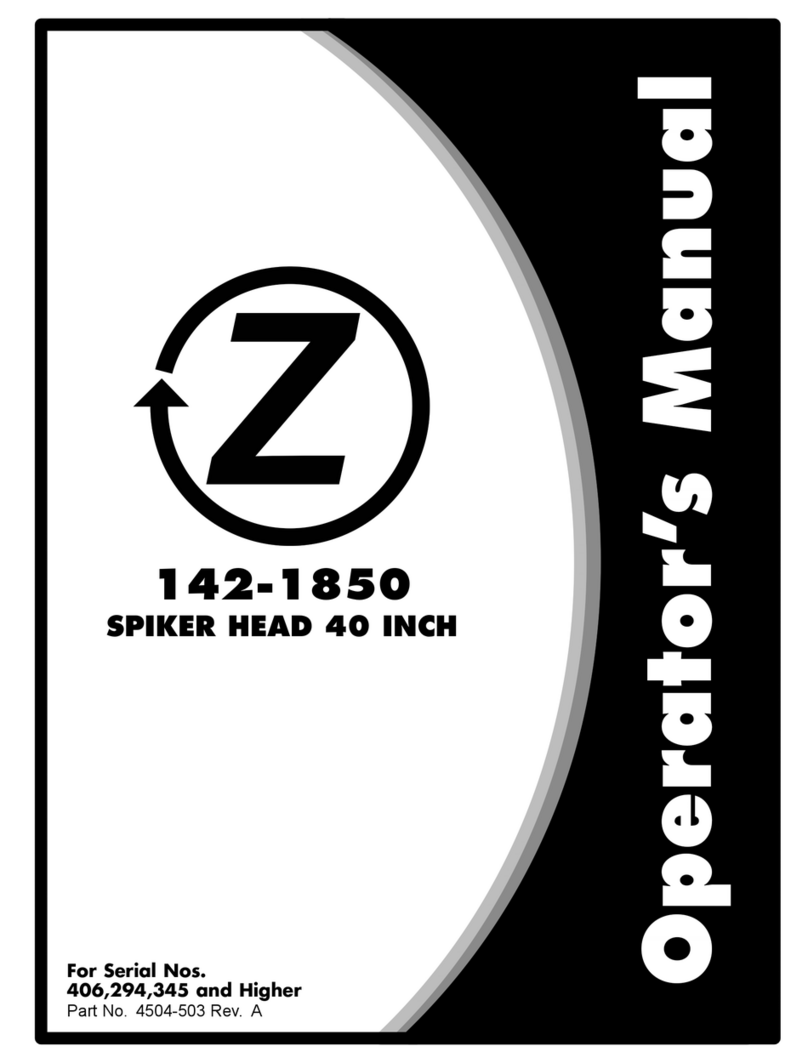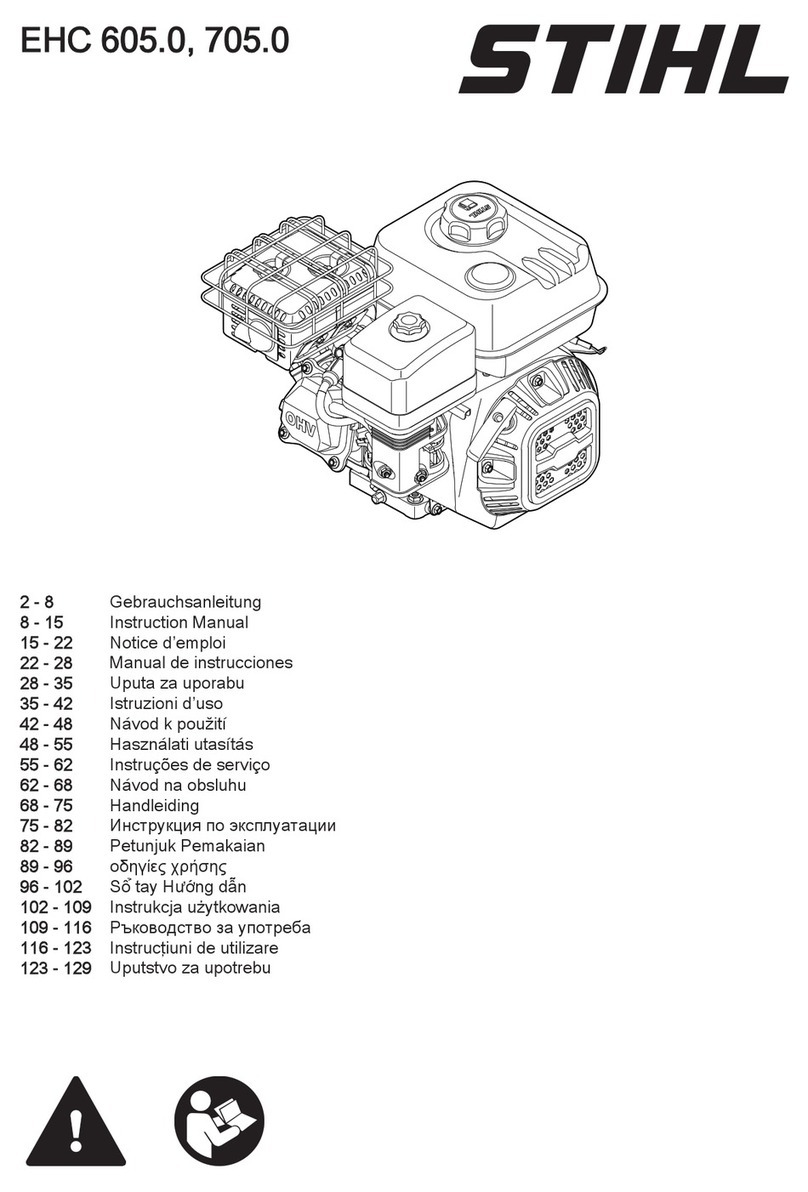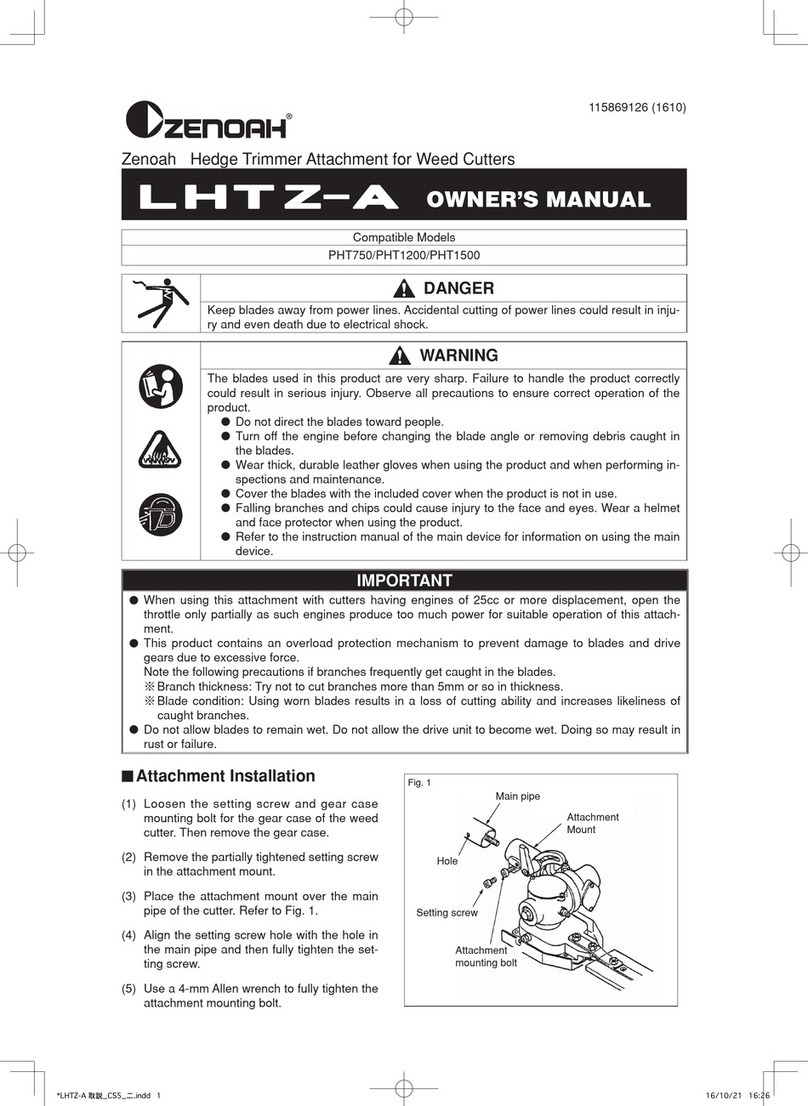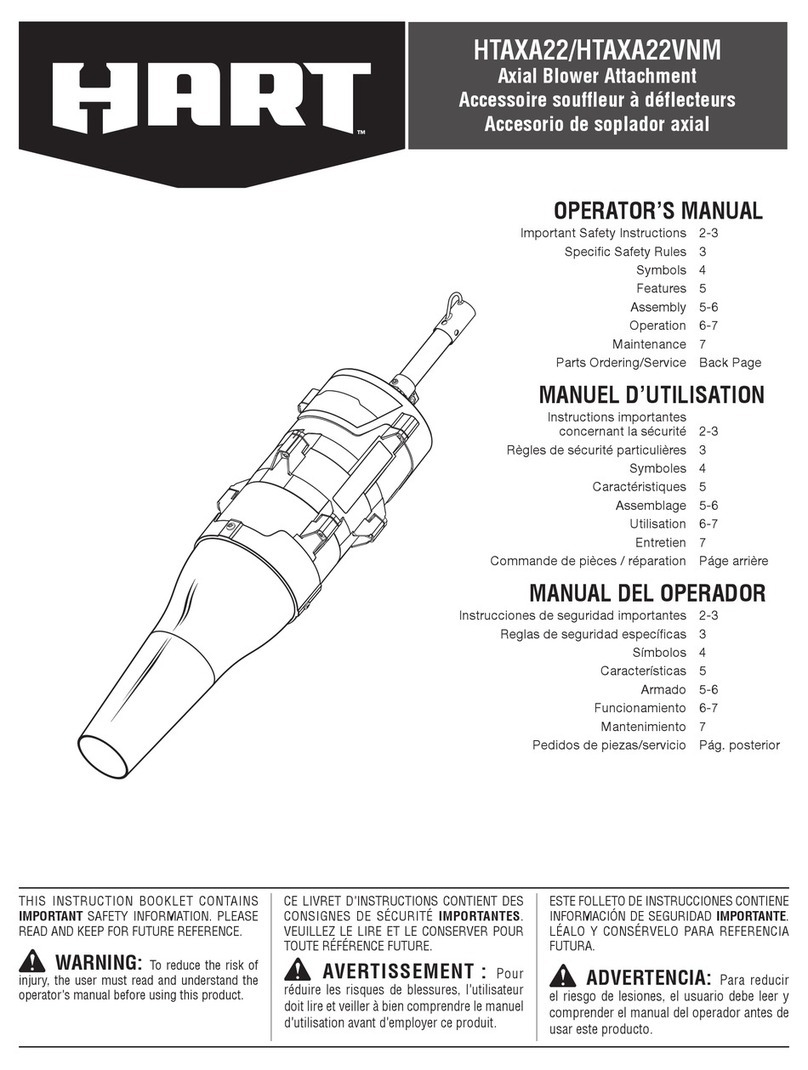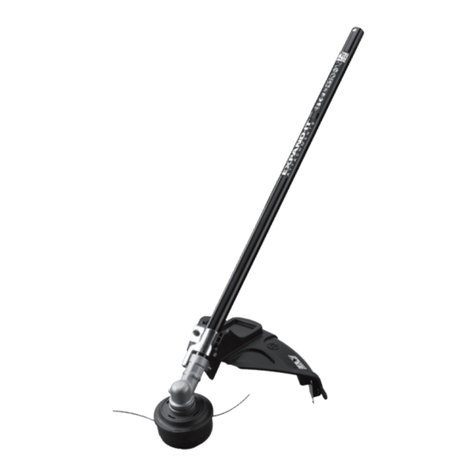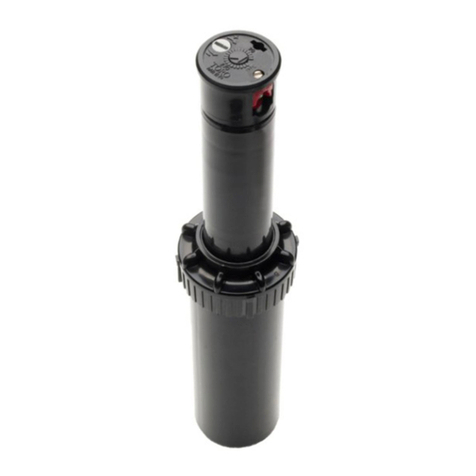Avantco A2808 User manual

Rotary Hoe 2012 1
Please read this manual carefully before using the equipment, and follow
all instructions.
Keep this manual for later reference.
Operator’s
Operator’sOperator’s
Operator’s
manual for Attachment
manual for Attachmentmanual for Attachment
manual for Attachment
R
Ro
ot
ta
ar
ry
y
H
Ho
oe
e
Product number: 300-700-series loaders: A2808
A21163
200-series loaders: A21102

Rotary Hoe 2012 1
CONTENTS
1. Foreword ..............................................................................................................................................3
2. Designed purpose of use ......................................................................................................................3
3. Safety instructions for the rotary hoe.....................................................................................................3
4. Rotary Hoe specifications......................................................................................................................5
5. Assembly of the rotary hoe....................................................................................................................6
5.1. Mounting the rotary hoe to the loader..............................................................................................6
5.2. Connecting and disconnecting the hydraulic fittings.........................................................................7
5.3. Field roller.......................................................................................................................................8
5.4. Storage of the rotary hoe.................................................................................................................9
6. Using the rotary hoe..............................................................................................................................9
6.1.1. Direction of rotation................................................................................................................................10
6.1.2. Slope operation......................................................................................................................................10
6.2. Adjusting the cultivation depth.........................................................................................................10
7. Inspections, maintenance and servicing................................................................................................10
7.1. Cleaning and lubricating the rotary hoe...........................................................................................11
7.2. Rotary hoe blades...........................................................................................................................12
7.3. Checking and adjusting the drive chain ...........................................................................................12
8. Warranty terms.....................................................................................................................................13
Appendix: EC Declaration of Conformity
This manual uses the following warning symbols to highlight factors that must be taken into account to
reduce the risk of personal injury or property damage:
DANGER:
This safety symbol refers to important safety information in this manual. It warns of
an immediate hazard that could cause serious personal injury or property damage.
Read the warning text accompanying the symbol carefully and ensure that other
operators are also familiar with the warnings, since personal safety is at stake.
Note:
This notice symbol indicates information about the correct operation and
maintenance of the equipment.
Failure to observe the instructions accompanying the symbol can lead to
equipment breakdown or other property damage.
In addition to the safety instructions included in this manual, you must observe all occupational safety
regulations, local laws and other regulations concerning the use of the equipment. Due to continuous
product development, some of the details in this manual may differ from your equipment. We reserve the
right to change the contents of the manual without notification. Original instructions.

3(12)
1. Foreword
Avant Tecno Oy would like to thank you for your purchase of this AVANT attachment. It has been designed
and manufactured on the basis of years of product development and experience. By familiarising yourself
with this manual and following the instructions, you ascertain your safety and ensure the reliable operation
and long service life of the equipment. Read the instructions carefully before starting to use the equipment or
performing maintenance.
With these instructions, even an inexperienced user can use the rotary hoe and loader safely. The manual
also includes important instructions for experienced AVANT operators. Ensure that all persons using the
equipment have received proper guidance and familiarised themselves with the manual and all safety
instructions before using the equipment. Keep this manual at hand throughout the service life of the
equipment. If the manual is lost, you can request a new one from the retailer or manufacturer. If you sell or
transfer the equipment, be sure to hand over this manual to the new owner.
2. Designed purpose of use
This AVANT rotary hoe is an attachment designed and manufactured to be suitable for use with AVANT
multi purpose loaders. The rotary hoe is intended for soil preparation and finishing seed bed when renewing
lawn areas, flower beds, small fields and similar. When using the hoe, the loader is driven in reverse, so that
the loader wheels do not interfere with newly cultivated soil. The operating height of the hydraulically
operated rotary hoe can be adjusted. The rotary hoe can be equipped with a field roller that compacts the
ground after cultivating. The rotary hoe may be used with the rear lifting device available for specific loader
models. This operator’s manual covers only the use of the rotary hoe as attached front, on the loader boom.
Avant offers a range of soil cultivation equipment. The versatile and robust rotary hoe performs very well in
most general soil conditioning work in various operating areas. When deep cultivation with professional top
grade finish is needed, the Avant Stone Burier is the best choice. If renewing lawn areas is the most
common task for the equipment, we recommend the Avant Rotary Harrow, which requires less hydraulic
power allowing higher driving speed. The Stone Burier and the Rotary Harrow can also be equipped with a
seeding unit, making it possible to renew lawn areas with a single pass.
The attachments have been designed to require as little maintenance as possible. Regular maintenance
tasks can be performed by the operator. The blades can be sharpened and replaced. Not all maintenance
tasks can be performed by the operator; certain tasks must be left to qualified professionals. Appropriate
protective equipment and original spare parts must be used for the maintenance. Read the maintenance and
servicing instructions in this manual. Please contact your AVANT retailer if you have additional questions
about the operation or maintenance of the equipment or if you require spare parts or maintenance services.
3. Safety instructions for the rotary hoe
Please bear in mind that safety is the result of several factors. The loader-attachment combination is highly
powerful, and improper or careless use may cause serious personal injury or property damage. Due to this,
you should carefully familiarise yourself with the manuals of both the loader and the attachment before
starting operation. Do not use the attachment if you have not familiarised yourself with its operation and the
related hazards.
The purpose of these instructions is to help you to:
•use the equipment in a safe and efficient manner
•monitor and prevent any hazardous situations
•keep the equipment intact and ensure a long service life
•Improperly mounted rotary hoe may fall from the loader boom. When mounting the
attachment to the loader, ensure that the locking pins of the loader's quick attach plate
are in the lower position and that they have locked the rotary hoe to the loader.

4(12)
•Beware of the sharp rotating blades of Rotary Hoe. Never leave the driver’s seat if the
rotary hoe is running. Lower the hoe flat on the ground and wait until the blades have
stopped completely before going near the attachment.
•A heavy load on the loader boom affects the stability of the loader, and especially on
inclined terrain a lifted load may lead to overturning of the loader. Always transport the
hoe as low and close to the machine as possible to keep the centre of gravity low.
•Pay attention to the contours of the terrain and other hazards, such as branches and
trees reaching the driver's area. Pay attention to the surroundings and any other
persons and machines moving in the vicinity.
•Find out if there are buried electric cables, water lines or other similar obstacles laid
less than one meter deep from the ground surface. Hitting such obstacle may lead to
electric shock, fire, gas explosion or other serious hazards.
•The rotary hoe is to be used by one operator at a time. Do not approach or allow others
to approach the operating area when another person is operating the controls of the
loader.
•The safety distance from the rotary hoe is 5 metres. Beware of thrown objects at the
operating area and discontinue use immediately if other persons are closer than the
minimum distance from the equipment. Keep the rotary hoe in good conditions and in
correct working position so that throwing of material is minimized.
•When detaching the rotary hoe, ensure that it is secured against accidental movement.
To prevent the attachment from moving, lower it onto blocks of wood, for example, not
on its blades, which reach below the frame of the equipment.
•Check the blades regularly. Read the instructions on maintenance and servicing and
only use original spare parts.
•Never perform any maintenance or adjustments while the loader engine is running.
•Do not modify the structure of the attachment in a manner that would affect its safety.
•Also read the safety instructions for the loader in the loader manual.
Beware of the blades and risk of crushing especially during maintenance or when
removing blockages. Always stop the attachment by turning the auxiliary hydraulics
control lever to its neutral position before leaving the driver’s seat, shut down the
loader engine and release the residual pressure of the hydraulic system. Note that the
loader boom moves down and may be tilted even if the engine has been stopped.
Never go under a raised boom or attachment component.
Improper or careless use of the rotary hoe could result in serious personal injury to the
operator or bystanders. Familiarise yourself with the loader controls in a safe area.
Pay particular attention to the safe stopping of the attachment and the loader.
Remember to wear proper protective clothing:
•The noise level in the driver's seat exceeds 85 dB(A). Wear hearing protection while
working with the loader.
•The use of safety boots is recommended while working with the loader.
•Wear protective gloves when handling hydraulic hoses.

5(12)
4. Rotary Hoe specifications
Listed on the following page are the markings and labels fastened to the rotary hoe, which must be visible
on the equipment. Replace the warning labels, if they have become unclear or detached completely. New
labels are available via your retailer or contact information provided on the cover page.
The warning decals contain important safety information. Replace damaged or
missing decals with new ones.
Table 1 – Decal warning messages
Decal Explanation
A46771 Read instructions before use.
A46772 Do not go under a raised attachment;
stay away from raised equipment.
A46798 Risk of being squeezed between power
transmission components; do not use
without all covers in place.
A46799 Beware of thrown objects; keep a safe
distance from the equipment (2 m).
Table 2 –Rotary Hoe Specifications
Product number A21102 A2808 A21163
Working width: 1 000 mm 1 300 mm
Cultivating depth: 50 / 100 / 150 mm
Weight: 160 kg 180 kg
Number of blades and spare
part numbers: 8 x right hand blade A31979 +
8 x left hand blade: A31978
Product number and width
of the optional field roller: A2972
1 250 mm A21164
1 530 mm
Maximum input of hydraulic
energy: 60 l/min,
22,5 MPa (225 bar)
Suitable Avant loader* 216, 218, 220 (300)
420-528 (528)
630-750
Suitability recommendations are based on the width of the machine and the sufficiency of the loader's
hydraulic power. For more information, contact your AVANT dealer.
Identification plate of the attachment
A46771 A46772
A46798
A46799

6(12)
5. Assem ly of the rotary hoe
The rotary hoe is ready for use as delivered. Mount the attachment and its hydraulic hoses to the loader as
instructed. Read the instructions related to using the equipment and begin the practise of use at a safe area.
5.1. Mounting the rotary hoe to the loader
Attaching the attachment to the loader is quick and easy, but it must be done carefully. If the attachment is
not locked to the loader, it may detach from the loader and cause hazardous situations. In the worst case,
the attachment may slide onto the driver along a raised boom. For this reason, the attachment must under
no circumstances be raised over one metre when it has not been locked. To prevent hazardous situations,
always follow the attachment mounting instructions provided in the following pages. Also, remember the
general safety instructions from Chapter 3.
The attachment is installed to the loader boom by using the quick attach plate and the counterpart on the
attachment. The locking on the loaders is semi-automatic; the locking pins are lowered as they hit the pin
guides when tilting the attachment towards the loader. The attachment is attached to the loader as follows:
Step 1:
•Lift the quick attach plate locking pin / locking
pins up and turn them backwards into the slot
so that they are locked in the upper position.
•If your loader is equipped with a hydraulic
attachment locking system, see additional
instructions about the use of the locking system
from the relevant manuals.
•Ensure that the hydraulic hoses are not in the
way during installation.
Step 2:
•Turn the quick attach plate hydraulically to an
obliquely forward position.
•Drive the loader onto the attachment. If your
loader is equipped with a telescopic boom, you
can utilise this.

7(12)
Step 3:
•Lift the boom slightly – pull the boom control
lever backward to raise the attachment off the
ground.
•Turn the boom control lever left to turn the
bottom section of the quick attach plate onto the
attachment.
•Lock the locking pins.
Unlocked attachment may fall on the
boom or operator and cause injuries.
Before moving or raising the
attachment, ensure that the locking
pins are in the lower position and
come through the fasteners on both
sides.
Do not use the automatic locking of the locking pins at a height of over one metre. If
the locking pins do not return to the normal position when the front plate is tilted, do
not raise the attachment any more. Lower the attachment on the ground and secure
the locking manually.
5.2. Connecting and disconnecting the hydraulic fittings
The attachment is equipped with either standard quick couplings or the multiconnector system. If you want
to change the type of the hydraulic couplings, contact your Avant dealer or service point for instructions or
installation services. On 200-series loaders only conventional quick couplings are available.
Never connect or disconnect quick couplings or other hydraulic components while the
system is under pressure or if the control lever of the auxiliary hydraulics control lever
is locked on. Connecting or disconnecting the hydraulic couplings while the system is
pressurized may lead to unintended movements of the attachment, or ejection of high-
pressure fluid, which can cause serious injuries.
Connecting standard quick couplings:
Before connecting or disconnecting the standard quick couplings, shut down the loader engine and move
the auxiliary hydraulics lever on the loader to its extreme positions a few times. This way, there will be no
residual pressure in the system and it is possible to connect the fittings.
To connect and disconnect the standard couplings, move the collar at the
end of the female fitting. The hoses should be connected so that the
coupling equipped with a coloured cap is connected to the corresponding
coupling of the loader. Note that the protective caps on the loader and the
attachment can be fastened to each other during operation to reduce the
accumulation of dirt. When disconnecting the standard quick couplings a
small amount of oil may drip from the couplings. Wear protective gloves
and have some cloth at hand to keep the equipment clean.

8(12)
Always ensure that all three couplings are properly connected to the corresponding
counterparts on the loader. If any of the hoses is not properly connected, the hydraulic
motor will get damaged, even though the attachment may operate for a while.
In a 200-series machine, the hose can be connected by pushing the
coupling in the counterpart. When connecting and disconnecting the 200-
series hydraulics quick couplings, you should pay attention to their locking.
There is a small groove in the collar of all female couplings, and a small
ball near the collar. When connecting or disconnecting the groove and ball
need to be aligned. The locking prevents the female and male couplings
from being disconnected from each other by accident when the attachment
moves. The collar may also turn by accident into the locking position,
making it impossible to connect or disconnect the couplings.
Connecting the multiconnector system:
Align the pins of the attachment connector with corresponding holes of
the loader connector. The multiconnector will not connect if the
attachment connector is upside down. Connect and lock the
multiconnector by turning the lever towards the loader.
The lever should move easily all the way to its locking position. If the
lever does not slide smoothly, check the alignment and position of the
connector and clean the connectors. Also shut down the loader and
release the residual hydraulic pressure.
Disconnecting the hydraulics:
Before disconnecting the fittings, lower the attachment on solid and level surface. Turn the control levers of
the auxiliary hydraulics to its neutral position. Keep the fittings as clean as possible; use the protective caps
for the quick couplings on both the attachment and the loader. Dirt, ice, etc. may make using the fittings
significantly more difficult. Never leave the hoses hanging on the ground; place them on top of the
equipment.
When removing the attachment, always disconnect the hydraulic couplings before
unlocking the quick attach plate, to prevent hose damage and any oil spills. Reinstall
the protective caps on the fittings to prevent impurities from entering the hydraulic
system.
Releasing residual hydraulic pressure:
In case residual pressure is left in the hydraulic system of the attachment, it is often possible to disconnect
the hydraulic couplings, but it may be difficult to connect them the next time. If the fittings will not connect,
the residual pressure must be released by turning the auxiliary hydraulics control lever of the loader, when
the engine is turned off. To make sure that there will not be residual pressure in the hydraulic system of the
attachment, shut down the loader engine and move the auxiliary hydraulics control lever of the loader before
disconnecting the couplings.
5.3. Field roller
Field roller is an option for the rotary hoe available from your AVANT dealer. The roller is mounted on front
of the rotary hoe. Its purpose is to compress the cultivated soil for more even surface. The roller also makes
the working height adjustment more consistent and as the roller compresses the soil, more even surface can
be achieved. Mount the roller to the front of the hoe with the screws provided with it, in place of the side
skids illustrated on page 10.

9(12)
5.4. Storage of the rotary hoe
Store the rotary hoe in a way that it is not left on its blades or on its roller. Ensure that the hoe is properly
supported against any movement by placing it on appropriate means, such as on blocks of wood, for
example. Beware that the attachment could move unexpectedly and cause injuries if stored improperly.
Clean the attachment thoroughly before winter storage. Touch up the paint where needed and grease the
lubrication points to prevent rust damage.
6. Using the rotary hoe
Check the attachment and the operating area once more before starting to work. Quick inspection of the
lawn mower before starting to use it is part of ensuring safety and the best performance of the equipment.
•Before each use, check the general condition of the rotary hoe and of the loader. Ensure that the
blades are intact and can rotate freely, and that there is no string or other foreign material coiled
around the shaft of the rotary hoe.
•Remove all obstacles from the operating area, such as large tree branches or rocks, before starting
the operation. Remember correct working methods and avoid leaving the driver’s seat
unnecessarily. Remove or mark also all hidden obstacles that could cause damages or risks of
injuries, and make sure that there are no electric cables, water or gas pipes at the reach depth of the
equipment.
•Check regularly to ensure there are no hydraulic leaks. See maintenance instructions shown in
Chapter 7.
•Ensure that the loader and the attachment are used in a safe manner and as intended. Do not allow
children to operate the machine.
•Operate the attachment and the controls of the loader only when sitting at the driver's seat.
Before using the equipment, check that the attachment and the loader are intact and
that all protective covers are in place. Do not use the rotary hoe if the chain drive cover
at the side of the attachment or some other part of the protective cover is not in place.
Note that regardless of the protective housing of the rotary hoe, rocks, pieces of wood,
or other objects found at the operating area, may be ejected by the hoe. Stop the hoe if
there are others at a distance of less than 5 meters from the work site.
Clean the oil cooler core of the loader regularly; refer to the loader manual for more
instructions. Overheating of the oil decreases the power and affects the service life of the
hydraulic components of both the attachment and the loader.
To start the rotary hoe, turn the auxiliary hydraulics control lever of the loader to its locked position. The
rotary hoe is used with high engine rpm, and depending on the model of the loader and the hoe, one or two
auxiliary hydraulic pumps are used (where applicable). The rotary hoe is operated by reversing the loader,
so that the wheels of the loader will not press the cultivated soil.
The work is influenced by the following factors:
1. Driving speed
2. Loader engine revolutions, loader model, output power of auxiliary hydraulics
3. The type of soil being cultivated, its compactness and dampness
4. Cultivation depth
The denser the soil is, the more the rotary hoe requires hydraulic power from the loader. If the soil is loose,
slightly higher driving speed may be used, but on stiff and compact soil high engine revolutions must be
used and the driving speed must be relatively low. In some cases it may be beneficial to use low operating
depth to break the surface of the soil, and then till the soil more thoroughly with a second run.

10(12)
If the rotary hoe stops rotating, the driving speed has been too high or the hoe has hit a rock. If blades hit a
rock, lift the hoe slightly off the ground to avoid wearing or damaging the blades. If an obstacle on the
ground cannot be removed, try to go around it, as the rotary hoe should not be used to chop obstacles on
the ground.
Beware of risks of cutting and crushing near the rotary hoe. When removing a
blockage, the hoe may move or rotate unexpectedly immediately after the blockage
has been cleared. Always shut down the loader engine and release he residual
pressure of the hydraulic system before going near the attachment.
6.1.1. Direction of rotation
Check the rotating direction of the blades. The blades should
rotate clockwise when seen from the left side of the machine. The
hoe should rotate the same way as the wheels when reversing
with the loader. If the hoe rotates the wrong way, interchange the
hydraulic pressure hoses' places (when using conventional quick
couplings).
6.1.2. Slope operation
Using the equipment on inclined terrain and slopes requires extra caution. Watch for holes, bumps, rocks
and other possible hidden obstacles. Uneven terrain could overturn the machine. Use low speed and do not
make sudden changes in speed or direction. Try to use the rotary hoe by driving straight up or down the hill,
not across, to avoid excessive side tilting. If the loader stops while driving up a steep slope, first stop the
attachment and then reverse slightly. Exercise extreme caution when moving near ditches or embankments
as the machine could suddenly turn over in case an edge caves in. On 200-series loaders, It is
recommended to use the optional wheel weights for the best stability on uneven terrain.
6.2. Adjusting the cultivation depth
The working height adjustment works as intended when the
side skids are set parallel to the ground with the loader boom.
The height can be adjusted by setting the front of the skid to
one of the three possible options. One step equals about 50
mm change in the working depth.
If the hoe is equipped with the roller, the cultivation depth is
adjusted with the height and tilting of the loader boom. After
the tilting and height is set correctly, lift the hoe by using only
the boom lifting movement, without tilting the attachment. This
way the hoe can be lowered quickly to the correct operating
position and cultivation depth.
Keep the skids or the roller parallel to the ground for correct operation of the height
adjustment. Avoid pressing the attachment on the ground so hard that the front wheels of
the loader lift off the ground.
7. Inspections, maintenance and servicing
Continuous maintenance of the rotary hoe includes regular cleaning and lubrication of the equipment as well
as monitoring the condition of the blades. The drive chain must be checked and adjusted at least twice a
year or every 50 hours of use.

11(12)
If you notice that the working performance has decreased, the equipment vibrates or makes abnormal noise,
clean the attachment carefully and check the condition of the blades. See section 7.2 for more information
about the blades.
The rubber lip plate on front of the rotary hoe reduces the risk of thrown objects.
Replace faulty or worn rubber plate; do not use the rotary hoe if the rubber lip is
damaged or missing.
Ensure that the equipment is properly supported during all inspection, adjustment and
maintenance procedures. Ensure the support also when the rotary hoe has been
attached on the loader and note, that the loader boom may be moved even if the
loader engine is not running.
Check the condition of the hydraulic hoses and components when the engine has been turned off and the
pressure has been relieved. Repair all leaks immediately after detecting them; a small leak can quickly grow
into a big one. Do not use the equipment, if you have discovered a leak in the hydraulic system. Leaking
hydraulic fluid may penetrate skin and cause serious injuries. Hydraulic fluid is also harmful to the
environment.
Check hoses visually for cracks or abrasions. Monitor the wearing of the hoses and stop the use, if the
surface layer of the hose has worn off. If there are signs of leaking, to check the component, hold up a piece
of cardboard in the area where a leak is suspected. Finding any of these faults means that the hydraulic
hose or component must be replaced. Spare parts are available from your nearest AVANT retailer or service
point.
Never tighten a hydraulic fitting under pressure, since
the fitting may break and the released oil may cause
serious injuries. Do not use the equipment, if you
have discovered a fault in the hydraulic system.
7.1. Cleaning and lubricating the rotary hoe
Clean the rotary hoe as soon as possible after use, since this makes cleaning easier. Right after use, lift the
rotary hoe off the ground and rotate it on the air, starting slowly, to remove the largest lumps of soil from the
blades. Do not strike the hoe against the ground. You may use a pressure washer and mild detergent for
cleaning the equipment. Do not use strong solvents or spray directly at the hydraulic components or at the
labels on the attachment either. After washing lubricate the lubrication points.
The rotary hoe has two lubrication points, located at the ends of the
blade haft, to which a small amount of lubricant is added every 5-10
hours of use. The free end of the axle is directly accessible. To lubricate
the transmission end of the axle, the protective cover must be removed,
see figures in section 7.3. All lubrication nipples are standard R1/8”
nipples. Replace any damaged nipples.
Lubricant must be added approximately every 5 to 10 operating hours. Clean the end of the
nipple before greasing. Only add the grease amount of a couple of grease press pushes at
a time.

12(12)
7.2. Rotary hoe blades
The condition of the blades should be checked after every few uses. When the blades are in good shape,
they penetrate to the ground surface better and therefore the hoe needs less power to operate. If the
performance of the rotary hoe has weakened from the original, the blades have probably become very blunt
or some of the blades have been damaged. The blades wear down during normal use and they may bend of
crack as they hit rocks. If the blades are bent, they have deep notches, cracks or similar signs of damage,
the blades should be replaced with new ones.
The blade shaft is consists of pairs of left- and right-
hand blades, and they can be replaced independently
as needed. Highlighted in the adjacent figure are
blades A31979, total of 8 blades fitted on the shaft.
Evenly worn blades can be sharpened. Do not
sharpen the blades razor-sharp, since this will make
them wear down very quickly and over sharpness
does not improve the performance of the hoe. Note
that the blade temperature should remain as even as
possible during sharpening. Excess heating will
weaken the tensile strength and wear resistance of
the steel. Only use blades similar to the original ones.
Abnormal vibration that remains after thorough cleaning of the equipment may be a sign of imbalance of the
blade axle. Replace damaged blades as needed. Imbalance may lead to damage to the bearings. Contact
service, if the vibration persists.
If the blades have large notches or cracks or have worn down excessively, they must
be replaced. Always use good protective gloves when handling the blades.
7.3. Checking and adjusting the drive chain
1. Lower the hoe on the ground and keep it attached to the
loader. Shut down the engine and disconnect the hydraulic
couplings. Make sure that the hoe is secured against any
movement and is not lowered on its blades, as rotating the
blades creates a risk of pinching between the components.
2. Open the protective housing of the chain on the left chain of
the hoe by removing the two retaining screws. Clean the
housing and the surroundings of the chain. Also lubricate the
bearing of the lower sprocket.
3. Test the tension of the chain by moving it manually in
between the sprockets, as shown in the adjacent figure. If
the chain moves about one centimetre or less, the chain
does not need tensioning, and in this case you may reattach
the protective housing. Lubricate the chain with suitable oil.

13(12)
4. If the chain needs to be adjusted, first loosen the four screws
of the hydraulic motor base, partly below the upper sprocket,
as shown in the adjacent figure.
5. The chain is tensioned with the screws marked A and B on
the upper adjacent figure. Loosen the locking screw A first
and then tension the chain with the B screw, until the slack
of the chain is about 0.5 – 1 cm.
6. When the chain is at correct tension, lock the setting with
screw A and recheck the tension. Lubricate the chain and
reattach the protective housing.
Do not over tighten the chain. Too much tension on the chain damages the hydraulic
motor and the bearings.
8. Warranty terms
Avant Tecno Oy grants a warranty of one-year (12 months) for the rotary hoe from the date of purchase.
The warranty covers repair costs as follows:
•Work costs are covered, if the repair is not performed at the factory.
•The factory replaces any defective components or consumables.
The factory may reimburse the price of components purchased by the customer in special cases that have been agreed
in advance.
The warranty does not cover:
•Normal maintenance work, such as the replacement of blades or the belts, or parts and consumables required for it.
•Damages caused by unusual operating conditions or ways of use, negligence, structural changes made without the
consent of Avant Tecno Oy, use of non-original parts or lack of maintenance.
•Consequences of a defect, such as interruption of work or other possible additional damages.
•Travel and/or freight costs caused by the repair.

Rotary Hoe 2012 1
EY-vaatimustenmukaisuusvakuutus
EG-försäkran om överensstämmelse
EC Declaration of Conformity
EG-Konformitätserklärung
Valmistaja / Tillverkare / Manufacturer / Hersteller: AVANT TECNO OY
Osoite / Adress / Address / Adresse: Ylötie 1
33470 YLÖJÄRVI, FINLAND
Vakuutamme täten, että alla mainitut tuotteet täyttävät konedirektiivin turvallisuus- ja terveysvaatimukset (direktiivi
2006/42/EY muutoksineen). Seuraavia yhdenmukaistettuja standardeja on sovellettu:
SFS-EN ISO 12100-1, SFS-EN ISO 12100-2, SFS-EN 982, SFS-EN 708
Vi försäkrar härmed att nedan beskrivna produkter överensstämmer med hälso- och säkerhetskrav i EG-maskindirektiv
(EG-direktiv 2006/42/EG som ändrat). Följande harmoniserade standarder har tillämpats:
SFS-EN ISO 12100-1, SFS-EN ISO 12100-2, SFS-EN 982, SFS-EN 708
We hereby declare that the products listed below are in conformity with the provisions of the Machinery Directive
(directive 2006/42/EC as amended). The following harmonized standards have been applied:
SFS-EN ISO 12100-1, SFS-EN ISO 12100-2, SFS-EN 982, SFS-EN 708
Wir erklären hiermit, dass die nachstehend aufgeführte Maschine konform ist mit den Bestimmungen der EG-
Maschinenrichtlinie (EG-Richtlinie 2006/42/EG mit Änderungen). Die folgende harmonisierte Normen wurden
angewandt:
SFS-EN ISO 12100-1, SFS-EN ISO 12100-2, SFS-EN 982, SFS-EN 708
Kuvaus: Avant-kuormainten kanssa käytettävä hydraulitoiminen jyrsin
Beskrivning: Hydraulisk jordfräs; arbetsredskap för Avant lastare
Description: Hydraulic rotary hoe; attachment for Avant loaders
Beschreibung: Hydraulische Bodenfräse; Anbaugerät für Avant Radlader
Mallit / Modeller / Models / Modellen:
Avant 200 series 300-700 series
100cm A21102 A2808
Jyrsin
Jordfräs
Rotary hoe
Bodenfräse 130cm - A21163
Allekirjoitus / Namnteckning / Signature / Unterschrift: ____________________10.6.2010 Ylöjärvi, Finland
Risto Käkelä,
Toimitusjohtaja / Verkställande direktör /
Managing Director / Geschäftsführer


This manual suits for next models
2
Table of contents
